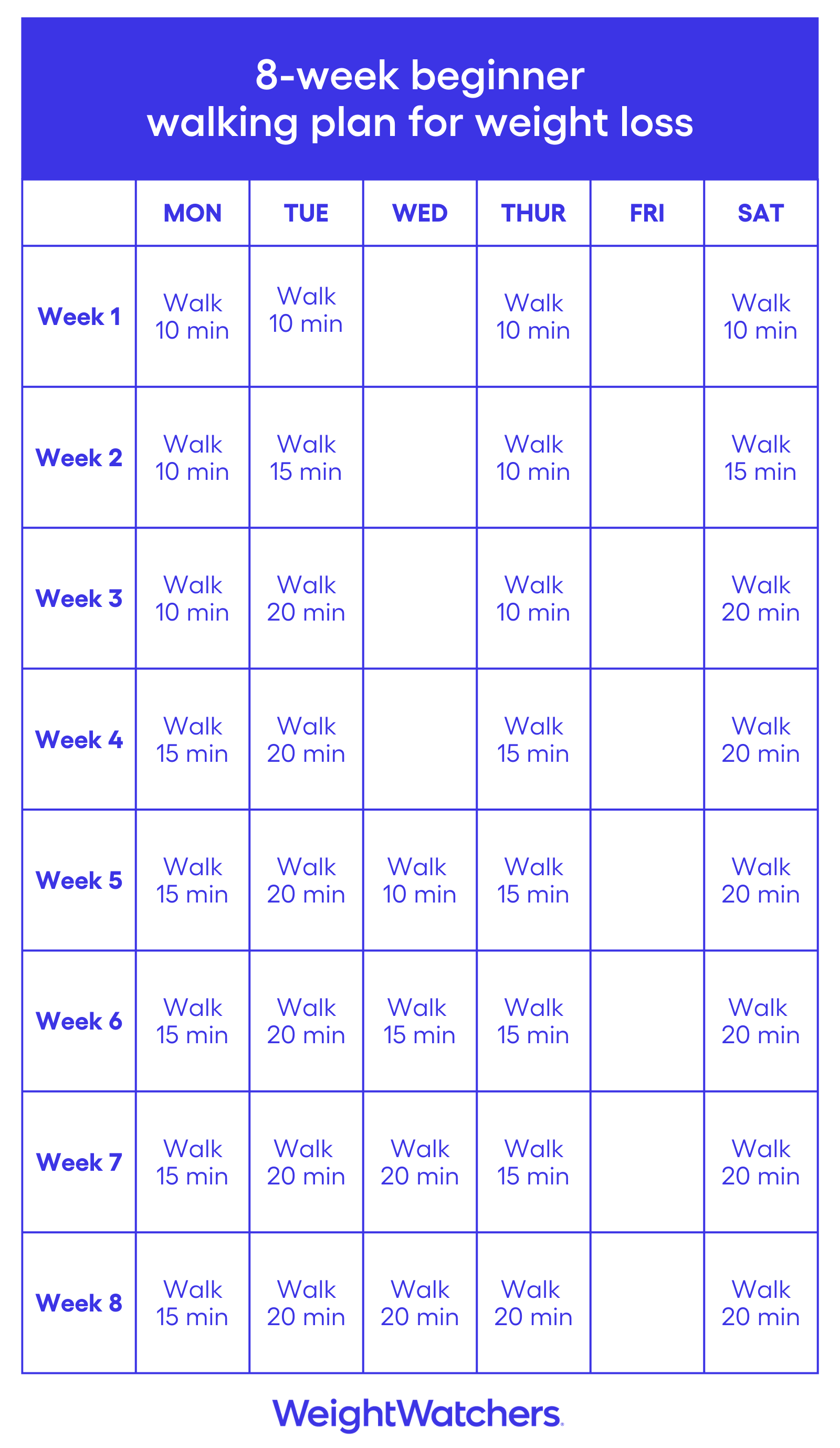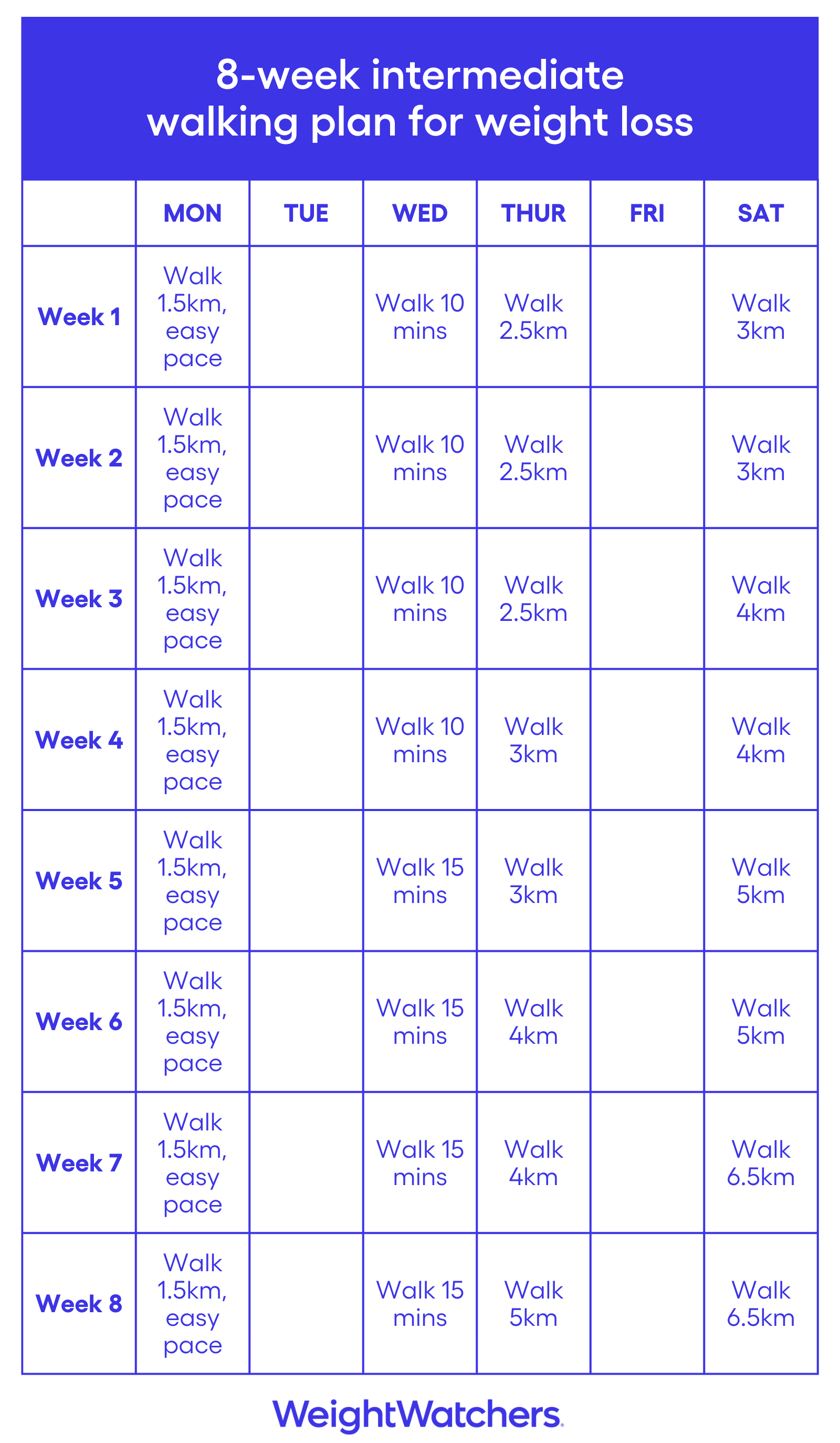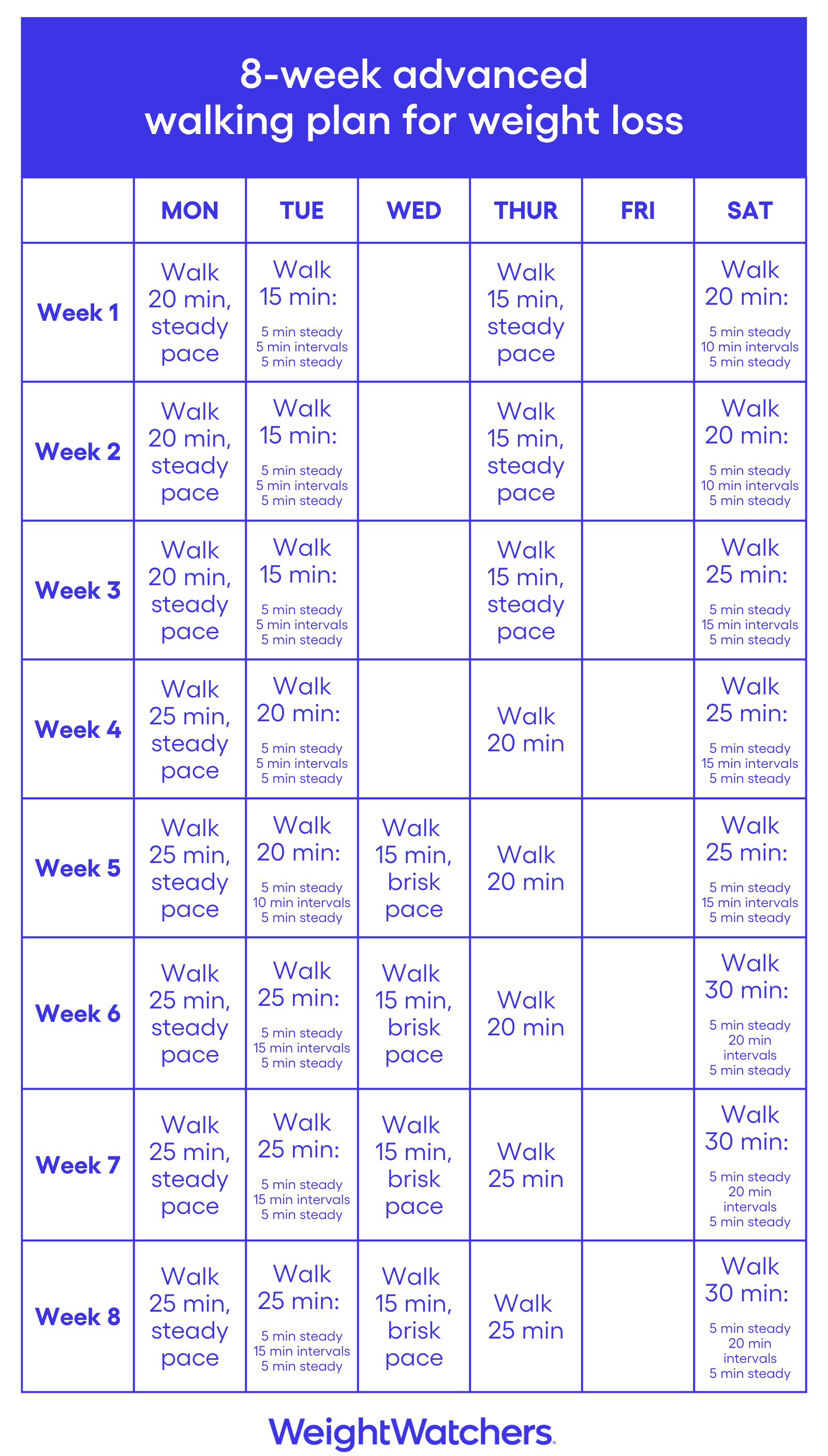Walking for weight loss


Included in this article:
- Walking and weight loss
- Health benefits of walking
- Beginner walking plan
- Intermediate walking plan
- Advanced walking plan
If you want to dial up your fitness efforts but feel a little intimidated, don’t worry: Exercise doesn’t have to be super-intense or punishing to be effective. In fact, you might be surprised to learn that walking is one of the most beneficial forms of low-impact activity. “It’s an activity that can bridge all life stages and is something you can come back to again and again,” says Michele Stanten, a certified fitness instructor.
Read on to learn more about walking for weight loss, the health benefits of walking, and three walking plans to help you go farther and faster.
Walking and weight loss
If losing weight is part of your overall health and wellness plan, you may be wondering if walking can help. All activity can help support weight loss, walking being no exception. Research has linked brisk walking with reductions in body weight, BMI, and waist circumference. It may even offer a bonus benefit when it comes to healthy-eating efforts: A 2015 study found that taking a 15-minute walk can help curb sugary-snack cravings.
How should you walk each day to lose weight? Public health guidelines recommend that adults do at least 150 minutes of moderate-intensity activity (like brisk walking) per week, and how and when you reach that goal is your choice. Check in with your current activity level, and aim to increase your walking in a way that works best for you. That might mean a 15-minute stroll after dinner during the week, with longer routes on the weekends; 30-minute walks five days a week; or simply getting up and walking whenever and wherever you can. If you’re just getting started, Stanten recommends focusing on consistency. Moving for even five or 10 minutes on your busiest days still counts and helps build the habit, she says.
Once you have a routine, you can experiment with raising the intensity level and trimming your time commitment. While both moderate- and high-intensity workouts support weight loss, high-intensity workouts raise your heart rate more and can impart the same benefits in less time. Research also suggests that people who do high-intensity activity may lose more body fat than those who do longer, less intense workouts. Try picking up your pace to complete your usual route in less time, or add short bursts of fast-walking or light jogging throughout your walk.
Ultimately, no matter how intense you choose to make your walks, the best activity for weight loss or any other health goal is one you enjoy and will do regularly.
Health benefits of walking
Beyond weight loss, the benefits of exercise are well established. But it’s easy to forget that the basic activity of walking counts toward your activity goals. “I often hear, ‘I just walked’ or “I’m just going for a walk’ and we all need to stop saying that,” Stanten says. Walking is free, easy on joints, and any movement is better than no movement. She also notes that the pros of walking are not reserved for people who walk as their main form of exercise. Even if you have a go-to fitness routine, taking a walk on an active recovery day or as an after-dinner activity with your family can offer physical and mental benefits.
1. May reduce disease risk
As we mentioned, incorporating any regular exercise into your routine can help improve overall health, and research has linked walking to the same benefits. Here are some of the chronic diseases that walking can help support:
- Heart disease: Even one extra hour of walking per week can help lower risk of heart disease in women, according to a study published in JAMA.
- Stroke: A 2013 study found that older adults who spent time walking had a reduced risk of stroke. While earlier research linked any pace to protective benefits, a recent meta analysis suggests that walking at a faster pace may lower risk even further.
- Type 2 diabetes: Research has also linked walking to reduced risk of type 2 diabetes, and improved health outcomes for people living with the disease.
- Certain cancers: While there are many risk factors for different types of cancers, a 2016 analysis found that leisure-time activity, including walking, was associated with a lower risk of more than a dozen types of cancer, including liver, lung, and kidney cancers.
- Osteoporosis: Walking can help prevent osteoporosis—and reduce the risk of bone fractures—by supporting bone density.
2. Could boost your mood
Research has found that just a 10- or 15-minute walk can have an impact on stress and creative thinking. Experts say this is often all it takes to affect neurotransmitters associated with positive mood.
3. Supports better sleep quality
Over a third of Australians aren’t getting enough shut-eye, according to the Sleep Health Foundation, and the effects are more than just feeling tired—lack of sleep can impact your physical and mental health. The good news: Regular moderate-to-vigorous physical activity may help you fall asleep faster, stay asleep longer, and generally sleep better. Some research even suggests that simply boosting your step count throughout the day could improve the snooze experience: A small observational study in Sleep Health found that people who walked more during their waking hours reported better sleep. Further research will probe the possibility of a direct link more closely.
4. May strengthen muscles
While walking on flat terrain usually doesn't build muscle, you can enhance your walk with resistance exercises to increase strength benefits. Look for routes with stairs or hills, do a set of lunges or squats every so often, add intervals, or wear wrist and ankle weights. Incorporating these challenges to your walks will boost the intensity, which public health guidelines recommend when looking to build muscle and bone. Considering walking with small hand weights or wearable weights? While they’re fine to try, it’s best to avoid using them if you develop signs of strain in wrists, elbows, and shoulders, Stanten says. And note that wearing or carrying weights may slow your pace, affecting calorie burn. An alternate idea: Add a separate day of strength training to your routine.
3 walking plans to help you reach your goals
Ready to lace up and hit the road (or treadmill), but not sure where to start? The beauty of walking is that you can do it almost anywhere, in whatever way works for you. And all forms of walking can support healthy weight management! But if you’d like a little guidance, a structured plan can help you set off on the right foot. Just remember: Before you start any new exercise program, it’s best to consult with your healthcare provider.
Start a walking program
If you're starting from zero, this is the program for you. Perhaps you've never exercised before or are returning to it after a long hiatus. Think of it as something you'll do to feel better physically and mentally. Designed to establish a walking routine, your goals are time-based, realistic, and attainable. No distances to reach—just you and your timer, counting the minutes.
This program is for you if:
- Your lifestyle has been sedentary up to now
- You're recovering from a long-term illness or severe injury
- You wish to build an endurance base and eventually be able to walk farther and/or faster
 *On rest days be sure to include some upper body movement and stretching.
*On rest days be sure to include some upper body movement and stretching.
Walk farther
Recording actual distances can be motivating as well as provide a strong sense of accomplishment. Keep in mind that building mileage should never be combined with an attempt to go faster. They should be mutually exclusive goals, and the focus of this program is expanding the distance you walk while staying healthy and injury-free.
This program is for you if:
- You've completed Start a Walking Program or have at least two months of walking a minimum of three days per week for 30 minutes at a time with no pain or discomfort
- You can commit to the time it takes to build mileage
- You're interested in the possibility of taking on a 10K walking challenge
 *On rest days be sure to include some upper body movement and stretching.
*On rest days be sure to include some upper body movement and stretching.
Walk faster
Perhaps you walk up to 30 minutes at a time most days of the week, sometimes longer. If you've been mobile for at least two months and feel ready to take your walking to the next level, you can jump in here — or follow the Walk Farther program — and build on your base. For the intervals, alternate between equal time (1:1 ratio) of a fast pace and a slow/recovery pace. (For example: Walk as fast as possible for 30 seconds, then slow to a recovery pace for 30 seconds.)
Keep in mind that, at any time during the course of this schedule, should you feel shortness of breath, lightheaded, or acute or lingering soreness in any joints, that's a sign to back off a bit. Our recommendation: Follow to the last week of the program above, then begin this one again at Week One. Pushing yourself to the point of pain or dizziness may result in greater setbacks than if you listen to your body and take care of it along the way.
This program is for you if:
- You're ready for a more challenging weekly routine
- You've completed Start a Walking Program
- You wish to continue to increase endurance and move a little faster
 *On rest days be sure to include some upper body movement and stretching.
*On rest days be sure to include some upper body movement and stretching.
KEY:
Stretching: Stretch hamstrings, quadriceps, hip flexors, and calves.
Upper body movement: Simple and designed to keep you active, do each movement for 30 seconds one after the other, then repeat twice. Eventually you want to work up to being able to do each movement for 1 minute.
- Alternating right and left jabs. Like a boxer, jab the air in front of you.
- Right and left overhead reach. Lean a little bit to the right and left as you alternately reach arms overhead.
- Forward giant arm circles. Move slowly and deliberately.
- Reverse giant arm circles. Squeeze shoulder blades together as your arms circle back.
- Wall cactus. Stand with your back against a wall, tailbone and head pressed against the wall, elbows level with shoulders and bent 90 degrees.
Intervals: Alternate between equal time (1:1 ratio) of a fast pace and a slow/recovery pace. For example, walk as fast as possible for 30 seconds, then slow to a recovery pace for 30 seconds. Feel free to go longer on the intervals and build up to 2 minutes at a time. As you feel stronger, start to increase your fast-pace times while keeping the slow/recovery pace times the same.
The bottom line
Exercise doesn’t have to feel hardcore to have benefits. Walking is good for your overall health, and for weight management. To begin walking for weight loss, start slow and steady—then gradually add more time, more distance, and finally more intensity to your walks. Just make sure you speak with your healthcare provider before starting a new exercise program.
